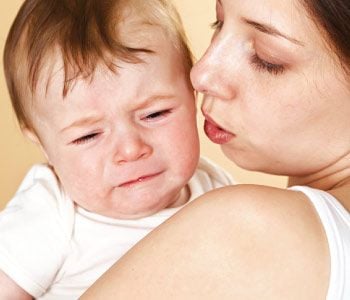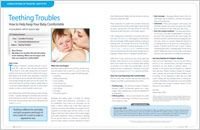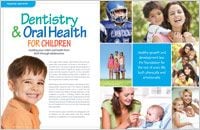

Teething refers to the process by which primary (baby) teeth emerge through the gums and become visible in the mouth. This usually begins between six and nine months of age, though it may start as early as three months or as late as one year. Usually, the lower front teeth erupt first, followed by the ones directly above. Most children have all 20 of their primary teeth by the age of 3 (View Tooth Eruption Chart).
Common signs that your baby is teething include:
You are most likely to notice any of the above from about four days before the tooth breaks through the gums up until three days after the tooth appears.
A less common teething issue is the formation of an “eruption cyst,” a small bubble-like swelling filled with fluid that covers an erupting tooth. Eruption cysts usually do not require treatment as the tooth will simply pop the cyst when it comes through.
While there has been some disagreement as to whether diarrhea, rashes and fever are signs of teething, these are more likely to be associated with an unrelated illness and should be reported to your pediatrician.
Teething babies get the most relief from cold and/or pressure on the affected area. This can be applied with:
Make sure not to actually freeze your baby’s teething ring or pacifier because this could burn if left in the mouth for too long. The outmoded “remedy” of rubbing whiskey or other alcohol on the gums is neither effective nor appropriate. Over-the-counter medication may be helpful, but always check the correct dosage with your pediatrician or pharmacist. These, too, should not be rubbed on the gums because they can burn. Numbing agents shouldn’t be used on babies under age 2 unless directed by a physician.
Remember, it’s best to start dental visits by your child’s first birthday to establish this lifelong health-promoting routine (View Age One Dental Visit Video).

Teething Troubles Teething is different for each baby, from the symptoms experienced to the length of time it takes for a tooth to appear. Although most infants make it through the teething process without much difficulty, occasionally the discomfort can be considerable. Find out what to look for and how to keep your baby comfortable… Read Article

Dentistry and Oral Health for Children Dear Doctor magazine brings you this wide-ranging overview of milestones and transitions in your child’s dental development. Learn how to protect your children from tooth decay, dental injuries, and unhealthy habits while getting them started on the road to a lifetime of oral health and general well-being… Read Article

How to Help Your Child Develop the Best Habits for Oral Health Proper oral health habits are easy to learn — and lead to behaviors that result in lifelong dental health. And the time to begin is as soon as your child’s first baby teeth appear. From toothbrushing for your toddler to helping your teenager stay away from tobacco, Dear Doctor magazine offers the most important tips for healthy habit formation through childhood and beyond… Read Article